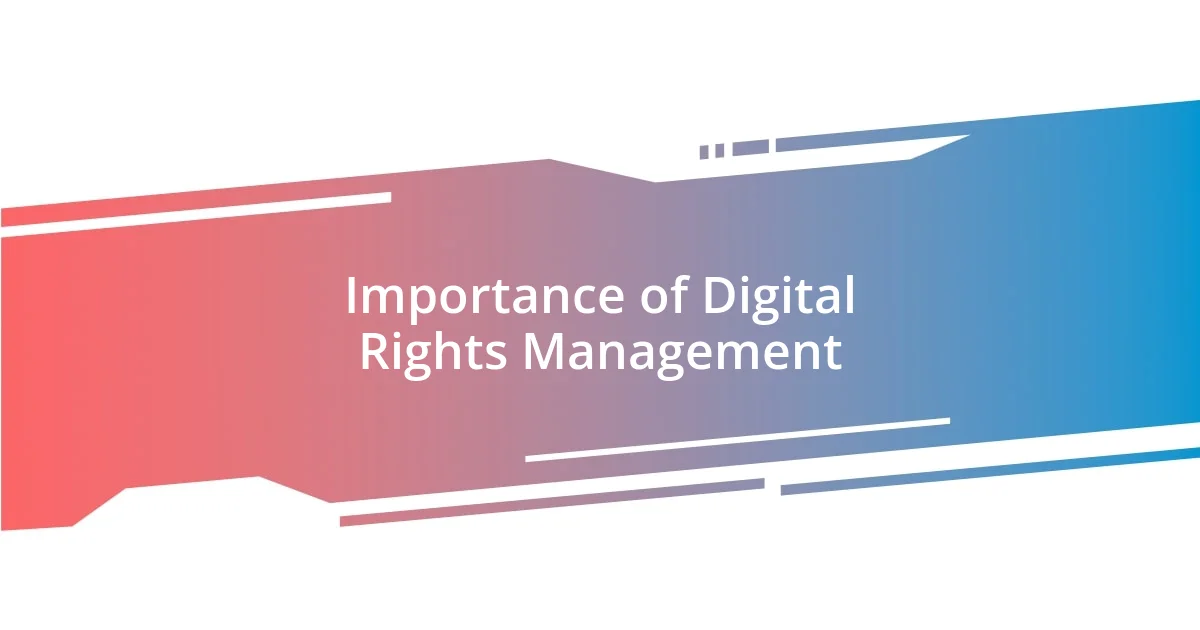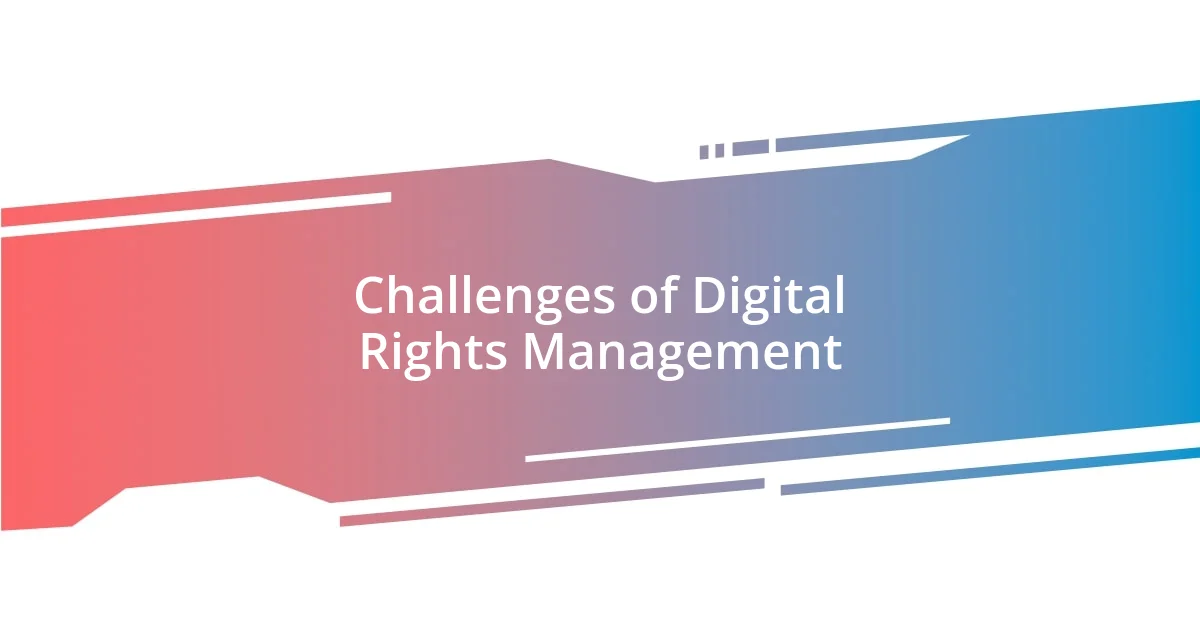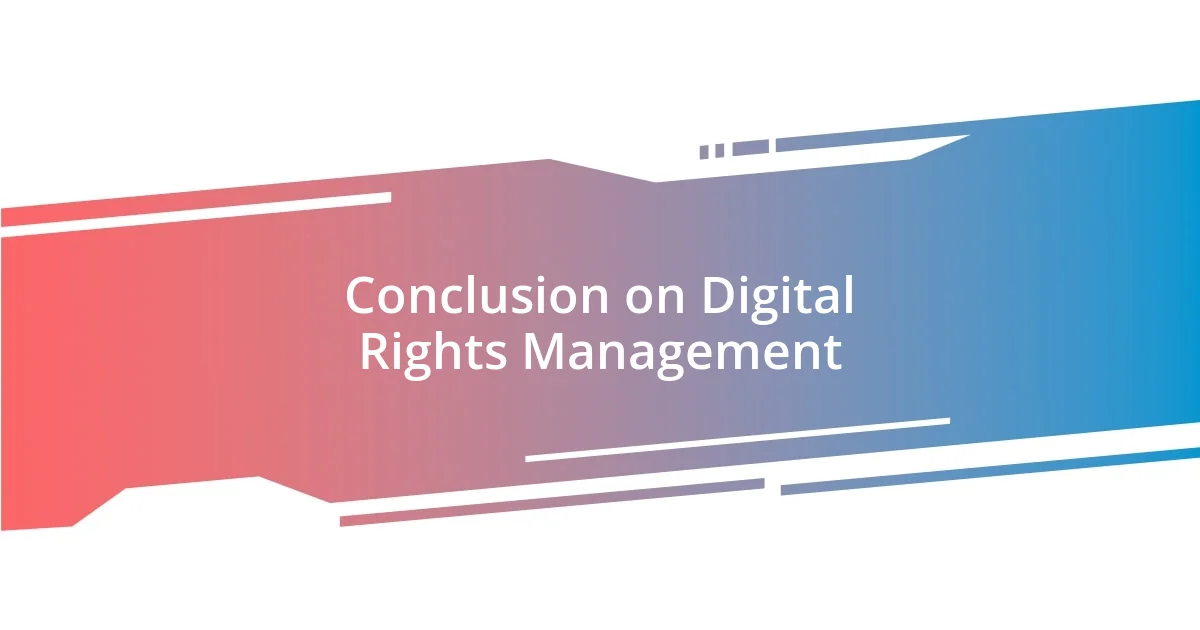Key takeaways:
- DRM aims to protect creators’ rights but often restricts access for consumers, leading to frustration and a need for balance.
- While DRM encourages innovation by safeguarding intellectual property, it can hinder sharing and accessibility, particularly for smaller creators and casual users.
- The emotional strain of DRM barriers raises questions about the effectiveness of current models, suggesting a need for solutions that respect both creator protection and user freedom.

Understanding Digital Rights Management
Digital Rights Management (DRM) can feel like a double-edged sword. While it aims to protect creators’ rights, I can’t help but wonder—does it also restrict access for devoted fans? I remember being eager to support an artist I loved, only to struggle with accessing their music because of restrictive DRM software. It was disheartening, to say the least.
At its core, DRM is all about controlling how digital content is used and shared. It enables publishers to dictate the terms of access, which sounds good in theory. However, from my experience, these systems often lead to frustration when legitimate buyers can’t use what they’ve purchased in the way they intended. Have you ever had a similar experience? It really makes you think about the balance between protecting creativity and ensuring consumer rights.
Many artists and creators support DRM because it can safeguard their livelihood. Yet, I often think—at what point does such protection become a hindrance? When I heard a musician lamenting about their work being locked behind barriers, I couldn’t help but sympathize. It emphasizes the importance of finding a middle ground where both innovation and access coexist harmoniously.

Importance of Digital Rights Management
The importance of Digital Rights Management (DRM) goes beyond just protecting the rights of creators; it plays a critical role in ensuring that the digital economy can flourish. I recall a situation where a friend tried to share an eBook with me after purchasing it. Unfortunately, the DRM restrictions prevented them from doing so. This not only limited their ability to share knowledge but also reinforced my belief that while DRM serves a protective purpose, it can inadvertently stifle sharing and collaboration among users.
Another key point is that DRM fosters innovation in content creation. By safeguarding intellectual property, creators feel more secure in their work, which encourages them to produce new and original content. I remember attending a workshop where a producer shared how securing their music through DRM allowed them to invest in better recording technology. This excitement in their voice made it evident that protecting their work was essential to their creativity and growth.
However, it’s important to acknowledge that the balance between protection and accessibility is delicate. Too often, I’ve found myself frustrated when trying to enjoy digital content that feels unnecessarily locked down. Picture trying to watch a movie on holiday, only to find out that DRM restrictions have rendered it inaccessible. It’s moments like these that highlight the compelling need for DRM systems to evolve, promoting not just protection but also equitable access for all.
| Aspect | Importance |
|---|---|
| Protects Creators’ Rights | Ensures artists receive fair compensation for their work. |
| Encourages Innovation | Provides security for creators to produce new content. |
| Facilitates Licensing | Helps manage the distribution of digital content to prevent piracy. |

Challenges of Digital Rights Management
Digital Rights Management (DRM) presents a series of formidable challenges that can often overshadow its intended benefits. I remember the frustration of trying to transfer a digital album I’d bought to my phone, only to encounter an error due to DRM restrictions. It’s not just me; so many users face barriers that make them feel trapped in a digital maze. This experience highlights a critical tension: how can we protect creators while ensuring consumers have genuine access to purchased content?
Here are some challenges I’ve observed:
- User Frustration: Legitimate buyers often struggle with limits on how they can use their purchases.
- Accessibility Issues: DRM can prevent sharing and accessing content across different devices or platforms.
- Market Limitations: Small creators may find it challenging to navigate complex DRM systems, potentially stifling their reach.
Navigating these challenges can feel overwhelming. There’s a sense of sacrifice on both sides—creators want to safeguard their work, and fans want to enjoy their purchases freely. It makes one wonder, where’s the happy medium? Just as I’ve experienced the emotional rollercoaster of trying to enjoy my favorite tunes, so too does the industry face an uphill battle in balancing rights and access.

Impact on Consumers and Creators
When evaluating the impact of DRM on consumers and creators, the divide often feels quite pronounced. I remember purchasing a digital film I was eager to watch, only to realize it was only accessible on one device. I couldn’t help but feel exasperated; it made the experience less enjoyable and left me wondering if my investment was truly valued. What good is a product if you can’t access it freely?
On the flip side, I’ve spoken with numerous creators who feel that DRM is a necessary evil. One indie game developer told me that without DRM, they would struggle to make a living from their creations. Their passion was palpable as they expressed how protecting their work empowers them to continue developing unique experiences. Yet, I can’t help but question if there’s a way to make our digital landscape more user-friendly without sacrificing that essential protection.
Then there’s the emotional strain that comes from these restrictions. I think about how often I’ve struggled with accessing not only movies and music but also eBooks I had legitimately purchased. It’s left me wondering whether the tension between consumer rights and creator protection is leading us toward a more open digital space or just creating barriers that frustrate everyone involved. How can we create a solution that respects both parties?

Conclusion on Digital Rights Management
When considering the implications of Digital Rights Management, it’s clear that a balance is crucial yet elusive. I’ve often found myself reflecting on the last time I wanted to re-watch a series but was met with DRM barriers that restricted my view to a single platform. It feels like a tug-of-war between security and accessibility, leaving both creators and consumers in a tricky position.
From my perspective, the real challenge lies in the perception that DRM serves as an invisible wall. There are moments when I’ve hesitated to buy digital content, worrying that I may lose access to something I’ve paid for at any time due to these limitations. This reality can deter potential customers, ultimately affecting creators’ sales—how are they to thrive if buyers feel hesitant?
In conclusion, while DRM was designed to protect intellectual property, it often feels more like a maze of restrictions than a safeguard. As I navigate my digital life, I can’t help but wonder if there are alternatives that could provide creators with the protection they need while allowing consumers the freedom they crave. Isn’t there a way we could evolve our approach to embrace both respect for creativity and the joy of open access?















